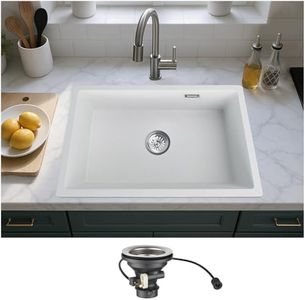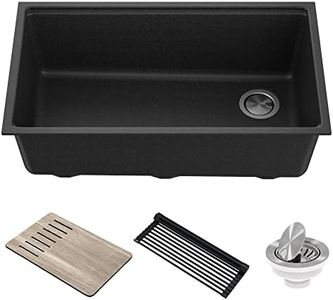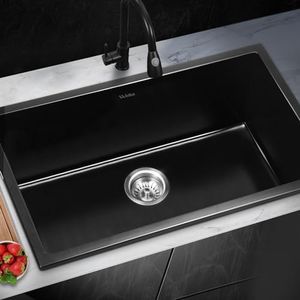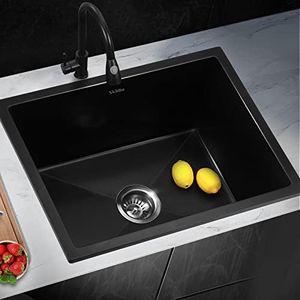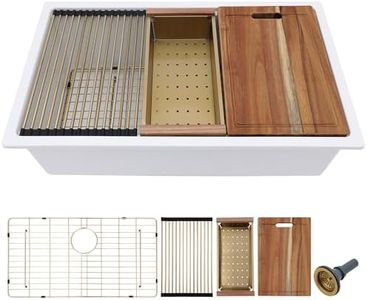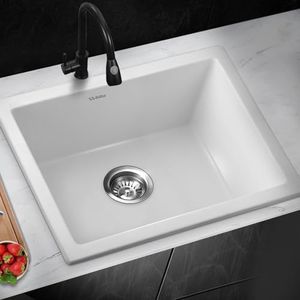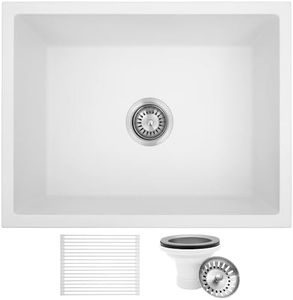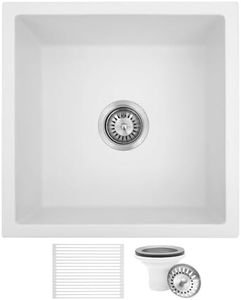We Use CookiesWe use cookies to enhance the security, performance,
functionality and for analytical and promotional activities. By continuing to browse this site you
are agreeing to our privacy policy
10 Best Granite Composite Sinks
From leading brands and best sellers available on the web.By clicking on a link to a third party's website, log data is shared with that third party.
Buying Guide for the Best Granite Composite Sinks
Choosing a granite composite sink is about blending functionality with style for your kitchen. These sinks are known for being durable, stylish, and resistant to most scratches and stains. When shopping for one, you need to look beyond just the color and consider how the sink will be used in your daily life. The right sink should match both the needs of your household and the design of your kitchen. Pay attention to size, durability, bowl configuration, and installation method for the best long-term satisfaction.Material CompositionGranite composite sinks are made by combining crushed granite stone with acrylic resins. This mix determines the sink’s durability, density, and look. A higher percentage of granite means a tougher, denser, and more scratch-resistant surface, but might also be heavier. Lower granite content can mean a lighter sink, but one that may be less durable. If you’re after maximum longevity and resistance to daily wear, go for sinks with high granite content. For lighter use or where weight is a concern, a lower granite percentage may work just fine.
Sink Size and DimensionsThe size of your sink determines what it can handle and how it fits into your countertop. Larger sinks can accommodate more or bigger dishes, but require more counter space. Smaller sinks are more suited to compact kitchens or for secondary uses. Measure your available space carefully and consider what you typically wash—if you cook often and use large pots, a bigger sink is helpful. For light, infrequent washing or as a bar sink, smaller sizes may be better.
Bowl ConfigurationGranite composite sinks come in single bowl, double bowl, or even triple bowl setups. Single bowl sinks offer one large space for washing big items, while double bowls can separate tasks (like washing in one and rinsing in another). Triple bowls are more for specialized uses. If you multitask or have a busy kitchen, double bowls can make work more efficient. For simpler kitchens or where space is limited, a single bowl usually suffices.
Installation TypeThere are a few main installation methods: undermount, top-mount (drop-in), and farmhouse (apron-front). Undermount sinks fit beneath the counter for a sleek look and easy cleaning, while top-mount sinks are set in from above, often easier to install or replace. Farmhouse styles create a deep basin with a distinctive exposed front. Pick the installation type that matches your countertop, your installation preferences, and your desired kitchen look.
Color and FinishGranite composite sinks come in many colors, from classic black and white to browns, grays, and even more colorful options. Matte finishes dominate, giving a modern, subtle look. Your color choice should complement your kitchen decor and hide stains or water spots as much as possible. Darker colors generally hide marks better, while lighter ones can brighten the space. Think about which color will maintain a fresh appearance with your cooking habits and cleaning routines.
Resistance to Stains and ScratchesOne of the biggest advantages of granite composite sinks is their resistance to scratches and stains. However, the specific level of resistance can vary. High-quality sinks have more uniform, dense surfaces that better resist everyday wear and discoloration from foods, cleaners, or metal pans. If you do a lot of heavy-duty washing or are concerned about scratches from heavy pots, prioritize a sink with well-reviewed resistance properties.
Ease of Cleaning and MaintenanceHow easy a sink is to clean affects your everyday experience. Granite composite sinks naturally resist stains and buildup, but some finishes and colors are easier to maintain than others. Look for sinks that are described as non-porous and that don’t require special sealants. Lighter sinks may need more frequent wiping to stay looking spotless, while darker ones can hide marks between cleanings. Match your choice with how much time you want to spend on upkeep.
